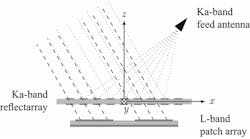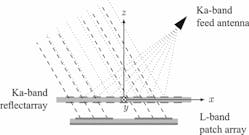By playing to the strengths of both the L- and Ka-bands, a shared-aperture communications antenna could operate at a high data rate in good weather without completely losing its connection in inclement weather. In collaboration with Cobham Satcom, researchers from the Technical University of Denmark—Thomas Smith, Ulrich Gothelf, Oleksiy Kim, and Olav Breinbjerg—have developed a shared aperture antenna array. It leverages a cost-effective printed-circuit-board (PCB) substrate for multiband antenna operation. Using a frequency-selective surface as the groundplane of the Ka-band reflectarray structure enables a compact structure. The L-band patch antenna array sits directly behind the reflectarray.
A concentric, dual split-loop element is designed for the Ka-band reflectarray with a concentric, dual-loop groundplane of equal trace width (0.2 mm). Adjustment of the split-loop elements changes the reflection phase. It also can be used to adjust the center frequencies over a nearly 10-GHz range. The reflectarray is printed on a 40-×-40-cm Rogers Duroid 5880 substrate that is 0.787 mm thick.
The Ka-band reflectarray was validated in the DTU-ESA Spherical Near-Field Antenna Test facility. It performed with receive and transmit aperture illumination efficiencies of 56% and 41%, respectively. A commercial L-band patch-array antenna was used to demonstrate the Ka-band translucence of the Ka-band reflectarray. It displayed only minor degradation of the L-band patch array’s performance. The measurements for that patch array were conducted from 1500 to 1700 MHz with a varying directivity of ±0.15 dB and maximum cross polarization below ±2.5 dB.
See “An FSS-Backed 20/30 GHz Circularly Polarized Reflectarray for a Shared Aperture L- and Ka-Band Satellite Communication Antenna,” IEEE Transactions on Antennas and Propagation, Feb. 2014, p.661.
This file type includes high resolution graphics and schematics when applicable.


